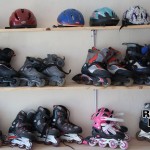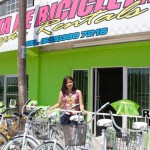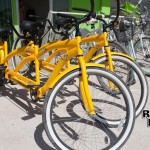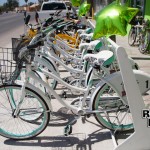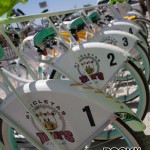Part I
There is an increasing wave of cyclists across the city. When you least expect it, two or three bikes zip by pedaling away at just about any given hour. You can see second-hand stores with various models for sale, as well as numerous bikes parked and locked up outside stores. Plus, there have been several organized Sunday cycling events as well as different activities to promote the sport, not to mention, the hike in gas prices and the doctor urging us to exercise.
I suppose you now hear a little voice insisting, “you should get a bike,” and honestly, you should. It’s good for you. Exercise, fresh air, and a little sun. Cycling is an environmentally friendly means of transport and Puerto Peñasco is an ideal spot without many hills to climb, plus its streets and distances are relatively short. In addition, cycling around town is so cosmopolitan.
Nevertheless, though the whole thing seems a little romantic, in practice it can be somewhat chaotic. There are cyclists heading toward you, against traffic; there are those who blow stop signs or pull reckless maneuvers in changing lanes or direction. There are also those who are just starting out who wobble, and those that seem to come out of nowhere.
I have seen many cyclists around without helmets, riding down the middle of the street, zipping around streets, spinning in circles, and cutting in front of both pedestrians and cars alike.
I imagine there are rules for biking on streets, for security’s sake or even just out of pure courtesy. It’s not just about getting on a bike and saying “here I go.” There are even rules at parks. No señores, there’s no “I have the right away” because that statement is widely used as a shield by pedestrians, cyclists, motorcycles, and even cars. Then there’s always the subjective “It’s that I KNOW how to drive (ride).” Accidents are a careful issue.
Armed with this curiosity, I decided to seek out knowledgeable folk, Roberto Fierro and my friend Aracely who I recalled participate in the cycling club Pelicanos de Peñasco.
To begin, Aracely pointed out there is a difference between cycling the sport and bicycling as a means of transport. There are also very interesting rules for mountain biking, as well for racing.
“As far as urban bicycling, a clarification must be made that the street is not a race track. A bicycle on a city street is a means of transportation, therefore rules must be respected and these rules actually exist within transit regulations,” she explained.
When she told me this, I was dumbfounded.
“Yes, even though you may not believe it,” she commented between bouts of laughter, “The Sonoran State Government just put out a list of rules, particularly those in Article 114 which begins with Section III Operation of Bicycles and Motorcycles.”
She passed me the link and I took a look. They are rules appealing to common sense, nothing out of the ordinary.
To begin with, the first rule pertaining to cyclists states: “Any operator of a bicycle or motorcycle has the same rights and is subject to the same obligations for operators of motor vehicles under this Law, except those that due to their nature are inapplicable.”
Another rule that caught my eye was the second: “It is prohibited for those less than 12 years old to ride bicycles on public roads…” It’s very important for the safety of children that parents always be watching, and they be biking in controllable spots. Just because many believe bicycles are a kids’ thing (typical Christmas or birthday gift), this does not mean kids should be left to roam the streets unsupervised.
“You should be really careful if riding in the city, obeying traffic signs just as if you were driving a car or a motorcycle. If there’s a stop sign, you have to stop; respect stoplights and not go around them,” advises Aracely.
After Aracely shared her tips with me, Roberto Fierro was able to come by the office during a free moment. Roberto is the President of the Pelícanos de Peñasco cycling club. Who better to tell us more about cycling? He is a friendly and very accessible individual.
“So tell me,” he began as we got comfortable in the office lounge, “What would you like to know?”
“Well, the basics,” I replied, “This is for those who are beginning: safety tips, how to ride along city streets, about the sport itself, where you can be contacted, etc.”
“Well,” he started in, “as far as cycling as a means of transport or in going out for a ride, which is what I see a lot of people doing, you don’t really need that much: a bicycle, helmet, and preferably glasses and gloves.”
“I knew about the helmet,” I said, “…but glasses and gloves?”
“Yes, because there are often small rocks and things kicked up and it’s better to be safe. The gloves are in case you fall, so you don’t scratch your hands; they slide more easily, and the helmet – well, that’s obvious but it’s because falls are to the side and often there’s no time to put one’s hands down first.”
“Within our group,” he went on, “there have been a few broken helmets, though nothing happened. But, imagine if that had been without a helmet! That would’ve been serious!
“What else?”, he asks me.
“The challenging topic of the road,” I stated, “How should cyclists behave on roadways?”
“Yes, that is very important,” he agreed, “When riding on streets you should go in the same direction as traffic, and not against it. ‘It’s so they can see me,’ say a lot of people… and yes, I tell them, ‘so you can see who’s going to run you over’ because that’s how accidents happen. No señor, you need to ride to the far right in the same direction as traffic. You also shouldn’t ride on sidewalks, which are for pedestrians, that’s a civilized way to get around.”
“Think of an intersection, such as Calle 13 and Blvd. Benito Juárez, for example,” he began to explain, “If a car is going to turn right, the driver checks to see no one is coming from the left in order to move into that lane. They changes lanes carefully, as it’s a continuous turn, and suddenly a cyclist shows up going against the traffic, right in the lane where the car is about to turn. The driver is startled and turns the wheel…in the best scenario, this creates a bit of havoc and words are exchanged. Yet, precisely at these types of corners is where most accidents occur because, it’s true I’ve seen it, cyclists don’t even stop at stop signs.”
In fact, dear readers and environmentally transport friendly enthusiasts, article 118 of the Transit Rules establishes in which lane bikes should be ridden. Pay attention, we all have the right to make it to our destination safe and sound!
…
Another point Roberto mentioned that caught my ear is that bicycles out in the evening or night have to have lights or reflectors. It makes sense, considering bicycles are within the regulations. I mention this so as not to leave it out and least you forget to check.
“Every bicycle shall be equipped with a front lamp with a single intensity that emits white light, allowing sight of persons and objects at a distance no less than 20 meters. Furthermore, there must be a red light on the back of the bicycle, visible at a distance of no less than 100 meters and at least a red reflector visible at night by any vehicle within a distance of between 30 to 100 meters when the headlights of said vehicle are projected directly at it.”
It’s not really that hard; possibly a few adjustments in order to be seen in the dark, in the event you tend to ride at night.
The port is quiet; if we follow the rules and the number of enthusiastic cyclists continues to grow we could get a lane just for bikes, and parking. We could become a cyclists’ culture so that they proudly call us a “cyclists port.”
Now, for those riding to work or just out for a simple ride, let me share something I learned the hard way – don’t wear loose clothing because you can get caught up in the chain, rip your pants, and fall on your head. Fold up your cuffs, or stuff them into your socks, so they’re as close as they can be to your leg and not get caught in the chain. What a friend of mine would do is use rubberbands or a Velcro strip, securing his pant cuffs to his legs.
Now that you’re ready to go out for a spin but don’t have a bike, there’s a business on Blvd. Benito Juárez (near the stoplight by Waldo’s) that rents bikes by the hour (and skates).
TITAS Club is a new business, belonging to Vanessa Espino and her mother Lizbeth Martínez. They charge $50 pesos / hour for bikes, $80 pesos / hour for tandem bikes (which looks quite fun), and $20 pesos / hour for skates.
Just present an official ID, pay, and you’re off to pedal. If you come by car, don’t worry, they have a parking area.
If you’d like to seriously cycle, I recommend checking into the local clubs including MTB Cyclists Club and Pelícanos de Peñasco.
So, ladies and gentlemen, there are no more excuses for making transportation into an extreme sport. Respect the rules in order to demand that others also do so!

